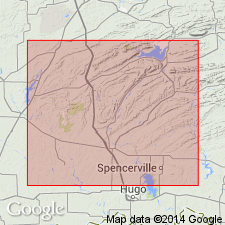
- Usage in publication:
-
- Tuskahoma siliceous shale member
- Modifications:
-
- Named
- Dominant lithology:
-
- Shale
- AAPG geologic province:
-
- Ouachita folded belt
Summary:
Named as third from base of four siliceous shale members of Stanley shale of Ouachita Mountains of southeastern OK, which are (ascending): Basal Ten Mile Creek, Tuskahoma, Middle Ten Mile Creek, and Moyers. Type locality designated as the exposure at center of west side of sec 22, T2N, R20E, Pushmataha Co, OK, in Ouachita tectonic belt province, about 4.6 mi east of Tuskahoma (for which it is probably named) on U.S. Hwy 271. Tuskahoma outcrops near the Potato Hills (Pushmataha Co), and is typically carbonaceous and pyritiferous. Some specimens contain abundant sapropelic and/or carbonaceous material, micaceous minerals, iron oxides, and quartz veinlets. Many shales from this unit are conspicuously laminated; thin sections perpendicular to bedding planes show thin, wavy, crenulated, discontinuous lenses of clay minerals and sapropelic material intermingled with cryptocrystalline to "isotropic" silica. Spore exines are the most characteristic fossils. Delicate radiolarian structures are well preserved in a few specimens, and scattered sponge spicules and radiolarian spines are not rare. Stanley shale is a sedimentary rock of typical geosynclinal facies; is of Mississippian age.
Source: GNU records (USGS DDS-6; Denver GNULEX).
For more information, please contact Nancy Stamm, Geologic Names Committee Secretary.
Asterisk (*) indicates published by U.S. Geological Survey authors.
"No current usage" (†) implies that a name has been abandoned or has fallen into disuse. Former usage and, if known, replacement name given in parentheses ( ).
Slash (/) indicates name conflicts with nomenclatural guidelines (CSN, 1933; ACSN, 1961, 1970; NACSN, 1983, 2005, 2021). May be explained within brackets ([ ]).

